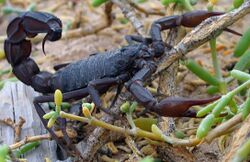Biology:Fattail scorpion
| Fattail scorpion | |
|---|---|

| |
| Arabian fat-tailed scorpion, Androctonus crassicauda. | |
| Scientific classification | |
| Domain: | Eukaryota |
| Kingdom: | Animalia |
| Phylum: | Arthropoda |
| Subphylum: | Chelicerata |
| Class: | Arachnida |
| Order: | Scorpiones |
| Family: | Buthidae |
| Genus: | Androctonus Ehrenberg, 1828 |
| Diversity | |
| About 30 species | |
Fattail scorpion or fat-tailed scorpion is the common name given to scorpions of the genus Androctonus, one of the most dangerous groups of scorpion species in the world.[1] The genus was first described in 1828 by Christian Gottfried Ehrenberg.[2]
They are found throughout the semi-arid and arid regions of the Middle East and Africa.[1] They are moderate sized scorpions, attaining lengths of 10 cm (just under 4 in).[3] Their common name is derived from their distinctly fat metasoma, or tail, while the Latin name originates from Greek and means "man killer".[4] Their venom contains powerful neurotoxins and is especially potent.[1] Stings from Androctonus species are known to cause several human deaths each year.[1] Several pharmaceutical companies manufacture an antivenom for treatment of Androctonus envenomations.[5]
The fat-tailed scorpion is nocturnal and enjoys making nests where they hide in crevices during the day to stay moisturized. [6] One of the main threats that the scorpions face is habitat loss. [7]
Geographic range
Androctonus is widespread in North and West Africa, the Middle East and eastwards to the Hindukush region. Countries where Androctonus species live including Egypt, Israel, India , Lebanon, Turkey, Jordan, Saudi Arabia, Yemen, Oman, United Arab Emirates, Qatar, Kuwait, Iraq, Iran, Afghanistan, Bahrain, Pakistan and Morocco.
Etymology
A rough English translation of the name Androctonus is "man-killer", from the Ancient Greek anḗr, andrós (ἀνήρ, ἀνδρός), meaning "man" and kteínein (κτείνειν), meaning "to kill". Crassicauda means fat-tailed, from the Latin crassus meaning "fat" and cauda, meaning "tail". Androctonus crassicauda is widespread throughout the Middle East and its name means "fat-tailed man-killer". Similarly, the Latin word for South is australis, from which Androctonus australis, "southern man-killer", derives.
Taxonomy
Taxonomic reclassification is ongoing, sources tending to disagree on the number of species.
Androctonus Ehrenberg, 1828 (30 species):
- Androctonus aeneas C. L. Koch, 1839*
- Androctonus afghanus Lourenço & Qi, 2006*
- Androctonus aleksandrplotkini Lourenço & Qi, 2007*
- Androctonus amoreuxi (Audouin, 1826)
- Androctonus australis (Linnaeus, 1758)
- Androctonus baluchicus (Pocock, 1900)*
- Androctonus barbouri (Werner, 1932)*
- Androctonus bicolor Ehrenberg, 1828
- Androctonus cholistanus Kovarik & Ahmed, 2013*
- Androctonus cacahuati Lourenço, 2023*
- Androctonus crassicauda (Olivier, 1807)
- Androctonus dekeyseri Lourenço, 2005*
- Androctonus donairei Rossi, 2015*
- Androctonus eburneus (Pallary, 1928)*
- Androctonus finitimus (Pocock, 1897)
- Androctonus gonneti Vachon, 1948*
- Androctonus hoggarensis (Pallary, 1929)
- Androctonus kunti Yağmur, 2023
- Androctonus liouvillei (Pallary, 1924)*
- Androctonus maelfaiti Lourenço, 2005*
- Androctonus mauritanicus (Pocock, 1902)
- Androctonus maroccanus Lourenço, Ythier & Leguin, 2009*
- Androctonus pallidus Lourenço, Duhem & Cloudsley-Thompson, 2012*
- Androctonus robustus Kovarik & Ahmed, 2013*
- Androctonus santi Lourenço, 2015*
- Androctonus sergenti Vachon, 1948
- Androctonus simonettai Rossi, 2015*
- Androctonus tenuissimus Teruel, Kovarik & Turiel, 2013*
- Androctonus tigrai Lourenço, Rossi & Sadine 2015*
- Androctonus togolensis Lourenço, 2008*
- Androctonus tropeai Rossi, 2015*
In captivity
Despite the risks of keeping such a dangerously venomous species in captivity, Androctonus scorpions are frequently found in the exotic animal trade,[where?] A. amoreuxi and A. australis being the most commonly available. The fat-tailed scorpion's main diet when in captivity consists of cockroaches, grasshoppers, and crickets. However, the fat-tailed scorpion is able to go months without consuming food. Scorpions will generally try to kill and eat anything which moves and is smaller than themselves.[8] Fat-tail scorpions kill their prey by first crushing them with their pincers and then injecting them with venom from their stingers.[9] Once the prey has been stung, it causes paralysis and allows the scorpion to consume it with ease.[10] Interestingly, the fat-tail scorpion can only ingest liquids.[11] To simulate the desert environment, the enclosure used to keep the scorpion in must be kept at a temperature of between 26 and 30 degrees Celsius (79–86 °F)[citation needed].
References
- ↑ 1.0 1.1 1.2 1.3 Hendrixson, B. E. 2006. Buthid scorpions of Saudi Arabia, with notes on other families (Scorpiones: Buthidae, Liochelidae, Scorpionidae). In W. Büttiker, F. Krupp, I. Nader & W. Schneider (eds.), Fauna of Arabia (pp. in press, ~100 pages). Basel, Switzerland: Karger Libri.
- ↑ Hemprich, F. G. & Christian G. Ehrenberg. 1828. Zoologica II. Arachnoidea. Plate I: Buthus; plate II: Androctonus. In: Symbolae physicae seu icones et descriptiones animalium evertebratorum sepositis insectis quae ex itinere per Africam borealem et Asiam occidentalem. Friderici Guilelmi Hemprich et Christiani Godofredi Ehrenberg, medicinae et chirurgiae doctorum, studio novae aut illustratae redierunt. Percensuit et regis iussu et impensis edidit Dr. C. G. Ehrenberg. Decas prima. ex Officina Academica, Venditur a Mittlero, Berlin
- ↑ "Arabian fat-tailed scorpion videos, photos and facts - Androctonus crassicauda | Arkive". http://www.arkive.org/arabian-fat-tailed-scorpion/androctonus-crassicauda/.
- ↑ "Dictionary of Scientific Scorpion Names". http://www.ntnu.no/ub/scorpion-files/dupre_2016_dictionary.pdf.
- ↑ "Antidotes In Depth, Jeffrey N. Bernstein". http://highered.mcgraw-hill.com/sites/dl/free/0071437630/358186/goldfrank_toxicology_chap115a.pdf.
- ↑ "Black Fat-tailed Scorpion" (in en). https://www.ead.gov.ae/Discover%20Our%20Biodiversity/Invertebrates/Black%20Fat-tailed%20Scorpion.
- ↑ "Black Fat-tailed Scorpion" (in en). https://www.ead.gov.ae/Discover%20Our%20Biodiversity/Invertebrates/Black%20Fat-tailed%20Scorpion.
- ↑ "Striped Bark Scorpion" (in en-US). http://bransonswildworld.com/striped-bark-scorpion-2/.
- ↑ "Black Fat-tailed Scorpion" (in en). https://www.ead.gov.ae/Discover%20Our%20Biodiversity/Invertebrates/Black%20Fat-tailed%20Scorpion.
- ↑ "Black Fat-tailed Scorpion" (in en). https://www.ead.gov.ae/Discover%20Our%20Biodiversity/Invertebrates/Black%20Fat-tailed%20Scorpion.
- ↑ "Black Fat-tailed Scorpion" (in en). https://www.ead.gov.ae/Discover%20Our%20Biodiversity/Invertebrates/Black%20Fat-tailed%20Scorpion.
External links
- The Scorpion Files: Buthidae
- Treatment of Androctonus stings at eMedicine
- Treatment of Androctonus stings
Wikidata ☰ Q593236 entry
 |



